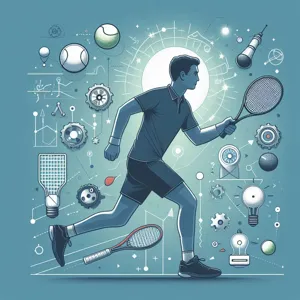Tennis is more than just a game; it’s a blend of strategy, agility, and mental fortitude that challenges players to continuously evolve.
Whether you’re a budding enthusiast eager to improve your skills or a seasoned player looking to refine your technique, unlocking your full tennis potential requires a deep understanding of your unique strengths and how to leverage them on the court. In this blog post, we will explore a variety of actionable strategies designed to enhance your performance, boost your confidence, and elevate your game to the next level. From targeted drills that sharpen your strokes to mental exercises that improve your focus, we’ll delve into the essential elements that can transform your playstyle and unlock the athlete within you. Join us on this journey to discover how, with the right approach, you can harness your strengths and become the tennis player you’ve always aspired to be.
1. Understanding Your Current Skill Level

Understanding your current skill level is the crucial first step in unlocking your tennis potential. Before you can enhance your strengths and address your weaknesses, it’s essential to take an honest inventory of where you stand. Begin by evaluating your performance in various aspects of the game—your serve, forehand, backhand, volleying, and overall court movement.
Consider keeping a journal to track your practice sessions, match performances, and specific areas that feel challenging. Are you consistently double-faulting on your serve? Is your backhand lacking power or accuracy? Perhaps your footwork needs improvement, making it difficult to reach those tricky shots. By identifying these focal points, you can tailor your training to build on your strengths while also shoring up any deficiencies.
Additionally, seek feedback from coaches, experienced players, or even fellow competitors. Their insights can offer a fresh perspective on your game, revealing strengths you may not fully appreciate and suggesting areas for growth that you might overlook. Video analysis can also be an invaluable tool; recording your matches or practices and reviewing them can highlight both your successes and areas needing improvement.
Remember, understanding your skill level isn’t just about identifying weaknesses—it’s also about recognizing and celebrating your strengths. Are you a natural net player with quick reflexes? Do you possess a powerful serve that can intimidate opponents? By acknowledging what you do well, you can build confidence and develop strategies that leverage these strengths during matches.
Ultimately, a clear understanding of your current skill level will guide your training, help you set realistic goals, and create a roadmap for improvement. Embrace this self-assessment journey, and you’ll be well on your way to enhancing your tennis prowess and unlocking your full potential on the court.
2. Identifying Your Unique Strengths
Identifying your unique strengths is a pivotal step in unlocking your true potential on the tennis court. Every player has a distinctive combination of skills, physical attributes, and mental approaches that contribute to their game. The first task is to conduct a thorough self-assessment to pinpoint what you excel at. Are you a powerful server who can dominate with your first serve? Perhaps you have an exceptional baseline game, allowing you to outlast opponents in long rallies. Maybe your agility gives you the edge in net play, letting you execute crisp volleys and deft overheads.
To effectively identify these strengths, consider keeping a journal of your practice sessions and matches. Document the shots that feel most natural to you, the times you feel most confident, and the strategies that yield success. Video analysis can also be a valuable tool; by recording and reviewing your matches, you can observe patterns in your play that highlight your strengths.
Additionally, seek feedback from coaches and experienced players. They can provide insights into your game that you may not notice yourself. For example, they might highlight your impressive court coverage or your ability to read your opponent’s shots, strengths that are crucial in formulating a competitive game plan.
Once you’ve pinpointed these strengths, embrace them. Tailor your training to enhance these areas further, whether it’s refining your serve, honing your footwork, or developing your mental game. Understanding and capitalizing on your unique abilities not only boosts your confidence but also sets the foundation for a more strategic approach to your gameplay. By knowing what you do best, you can craft a style that not only plays to your strengths but also keeps your opponents guessing, ultimately elevating your performance on the court.
3. Setting Clear, Achievable Goals

Setting clear, achievable goals is a fundamental step in unlocking your tennis potential and elevating your performance on the court. Without a clear direction, it’s easy to become overwhelmed or stagnate in your progress. Rather than vague aspirations like “I want to be a better player,” consider breaking down your objectives into specific, measurable outcomes.
Start by reflecting on your current skills and identifying areas for improvement. Are you aiming to refine your serve, increase your speed on the court, or enhance your strategic play? Once you’ve pinpointed these focal points, set short-term and long-term goals that are both realistic and challenging. For instance, a short-term goal might be to practice your serve for 30 minutes twice a week, while a long-term goal could involve participating in a local tournament within the next six months.
Document your goals and create a timeline to track your progress. This will help you stay accountable and motivated as you celebrate small victories along the way. Additionally, consider incorporating a mix of performance-based and outcome-based goals. While performance goals focus on improving specific skills—like hitting a certain percentage of first serves in—outcome goals might revolve around winning matches or improving your ranking.
Remember, the journey of enhancing your tennis skills is a marathon, not a sprint. Regularly reassess your goals as you progress; celebrate the milestones you’ve achieved, and don’t shy away from adjusting your targets to reflect your growth. By setting clear, achievable goals, you’ll not only sharpen your focus but also cultivate a sense of purpose that drives you to reach new heights on the court.
4. The Importance of a Tailored Training Routine
When it comes to unlocking your tennis potential, a one-size-fits-all approach to training simply won’t cut it. Every player has unique strengths, weaknesses, and playing styles that demand a customized training routine. This tailored approach ensures that you’re not only honing your existing skills but also addressing specific areas that may need improvement.
A well-structured training regimen begins with a thorough assessment of your game. This might involve analyzing your serve, groundstrokes, and net play, as well as evaluating your physical conditioning. By identifying your strengths—perhaps you have a powerful forehand or exceptional footwork—you can build on these assets, refining them to gain a competitive edge. On the flip side, pinpointing weaknesses—such as inconsistent backhands or stamina issues—allows you to dedicate focused training sessions to those areas, turning potential liabilities into newfound strengths.
Moreover, a tailored training routine should incorporate a mix of on-court drills and off-court conditioning. While practice matches and skill drills are essential for improving technique, integrating strength training, flexibility exercises, and cardiovascular workouts enhances your overall performance and reduces the risk of injury.
Consulting with a coach or fitness professional can further elevate your training plan, as they can offer insights into the latest techniques and methodologies that suit your individual needs. Remember, the key to maximizing your potential lies in the details. By committing to a personalized training routine, you’re not just preparing for your next match; you’re laying the groundwork for long-term success and growth as a tennis player. Embrace the journey of self-improvement, and watch how your game transforms on the court.
5. Strength Training for Tennis Players

Strength training for tennis players is a game changer, often serving as the backbone of an athlete’s performance on the court. While agility, speed, and technique are undeniably important, the ability to generate power and maintain endurance through strength training can elevate your game to new heights.
To harness your full potential, it’s essential to focus on a well-rounded strength training regimen that targets the key muscle groups used in tennis. This includes exercises that build explosive power in your legs for those powerful serves and swift sprints, as well as core workouts that enhance your stability and balance during rallies. Think squats, lunges, and deadlifts—these compound movements not only strengthen your lower body but also engage your core, leading to more powerful groundstrokes and serves.
Upper body strength is equally crucial, as a strong upper body enables you to hit with precision and control. Incorporate exercises like bench presses, rows, and shoulder presses into your routine. These will help develop the shoulder and arm muscles necessary for powerful serves and overhead shots, while also reducing the risk of injury.
Additionally, don’t overlook functional strength training, which mimics the movements you’ll perform on the court. Incorporate rotational exercises like medicine ball throws or cable twists to enhance your ability to change direction and maintain power during dynamic play.
Moreover, integrating flexibility and mobility training into your strength program can improve your range of motion, allowing for better shot execution and injury prevention. Yoga and dynamic stretching can complement your strength workouts, ensuring that your muscles are both strong and supple.
Ultimately, a structured strength training program tailored to your specific needs as a tennis player can lead to significant improvements in your game. Not only will you see enhanced performance in your serves and groundstrokes, but you’ll also develop the stamina to outlast your opponents during long matches. Embrace strength training as a vital component of your overall training strategy, and watch as your tennis potential unfolds on the court.
6. Improving Your Footwork and Agility
Improving your footwork and agility is essential for unlocking your full tennis potential. In a sport where split-second decisions can dictate the outcome of a match, the ability to move fluidly and swiftly around the court can set you apart from your competition. Your footwork forms the foundation of your game, allowing you to position yourself effectively for every shot, maintain balance, and react promptly to your opponent’s moves.
To enhance your footwork, start by integrating specific drills into your training regimen. Ladder drills are a fantastic way to develop quick feet and coordination. Set up an agility ladder on the ground and practice various patterns, focusing on speed and precision. Side shuffles, in-and-out movements, and forward-backward sprints can also improve your lateral quickness and explosiveness, key components in reaching those challenging shots.
Incorporating plyometric exercises, such as box jumps and lateral bounds, can further boost your agility. These explosive movements train your muscles to react swiftly, building the power you need for those quick bursts across the court. Additionally, don’t underestimate the importance of strength training. A focused regimen that targets your legs, core, and upper body will not only enhance your overall athleticism but also contribute to a more stable and powerful stance during play.
Lastly, practice makes perfect. Engage in match-play scenarios where you consciously focus on your footwork. Visualize the court as a grid and work on your positioning, ensuring you’re always ready to make your next move. By dedicating time to improving your footwork and agility, you’ll notice a significant enhancement in your overall performance, allowing you to chase down balls with confidence and dictate the pace of the game. With each practice, you’re not just becoming a better player; you’re unlocking your true tennis potential.
7. Developing Mental Toughness and Focus

Mental toughness and focus are essential components for any tennis player looking to unlock their full potential on the court. While physical abilities often take center stage in training sessions, the mental aspect of the game can make or break even the most skilled athletes. Developing mental resilience allows players to navigate the pressures of competition, maintain composure during critical moments, and bounce back from setbacks with renewed determination.
To cultivate mental toughness, start by incorporating visualization techniques into your practice routine. Spend a few minutes each day visualizing yourself executing successful shots, navigating challenging situations, and ultimately winning matches. This mental rehearsal not only boosts confidence but also prepares your mind for the realities of competition.
Another powerful tool is mindfulness meditation, which can enhance your ability to stay focused during matches. By training your mind to remain present, you can reduce anxiety and distractions that often arise in high-stakes moments. Consider dedicating time each week to mindfulness practices, such as deep breathing exercises or guided meditations, which can help you center your thoughts and regain focus when the pressure mounts.
Additionally, setting specific, achievable goals can foster a sense of purpose and motivation. Break down your training objectives into manageable tasks, and celebrate small victories along the way. This approach not only builds your confidence but also reinforces a growth mindset, reminding you that every challenge is an opportunity for improvement.
Finally, learning to manage your emotions during matches is crucial for maintaining mental toughness. Practice techniques for controlling your reactions, whether it’s a missed shot or a tough call from an umpire. Developing a routine for refocusing after setbacks—such as taking a deep breath, shaking off the error, or visualizing your next point—can help you regain control and push through adversity.
By prioritizing mental toughness and focus, you’ll not only enhance your performance on the court but also enjoy a more fulfilling and resilient journey as a tennis player. Embrace the challenge, stay committed to your mental training, and watch as your game reaches new heights.
8. Leveraging Video Analysis for Performance Improvement
In the age of technology, one of the most powerful tools at your disposal for enhancing your tennis game is video analysis. This method allows you to literally see your performance from a new perspective, uncovering strengths and weaknesses that may not be apparent during the heat of competition. By recording your practice sessions or matches, you can break down every aspect of your game—your footwork, stroke mechanics, and even your mental approach to various situations on the court.
Start by setting up a camera or using your smartphone to capture your gameplay from different angles. This will give you a comprehensive view of your movements and strategies. After recording, take the time to analyze the footage critically. Look for patterns in your play: Are you consistent with your serve toss? Do you find yourself rushing your shots under pressure? Are there moments when your footwork falters, leading to missed opportunities?
But don’t stop at self-analysis; consider sharing your videos with a coach or a more experienced player. Their insights can provide valuable feedback and suggestions you might not have considered. Additionally, many professional coaches utilize advanced software that allows them to dissect play in detail, comparing your strokes to those of top players. This can help you identify specific areas for improvement and set actionable goals.
Implementing the lessons learned from your video analysis into your training sessions can lead to significant gains over time. For instance, if your analysis reveals that your backhand is lacking, dedicate extra practice to that stroke, focusing on proper technique and foot placement. Over time, you’ll find that what once felt awkward becomes second nature.
Incorporating video analysis into your training regimen not only accelerates your learning curve but also enhances your self-awareness as a player. With each analysis, you gain deeper insights into your game, allowing you to make informed adjustments that can unlock your full potential on the court. So grab that camera, record your journey, and watch as your performance evolves with every frame!
9. The Role of Nutrition in Enhancing Performance
Nutrition is a fundamental pillar of athletic performance, serving as the fuel that powers your body during intense matches and grueling training sessions. For tennis players, where speed, agility, and endurance are paramount, the right dietary choices can make all the difference in unlocking your full potential on the court.
Firstly, understanding the importance of proper hydration cannot be overstated. Tennis matches can last for hours, especially in the heat of summer, leading to significant fluid loss through sweat. Staying hydrated not only helps maintain optimal physical performance but also enhances cognitive functions like focus and decision-making—crucial elements in a fast-paced game. Aim to drink water consistently throughout the day and consider electrolyte-rich sports drinks during longer matches to replenish lost minerals.
Next, focus on a balanced diet rich in carbohydrates, proteins, and healthy fats. Carbohydrates are your primary source of energy, providing the quick bursts needed for those powerful serves and swift court coverage. Opt for complex carbohydrates such as whole grains, fruits, and vegetables, which will sustain your energy levels over time. Protein is essential for muscle repair and recovery, making foods like lean meats, dairy, legumes, and nuts vital components of your post-match meals. Healthy fats, found in avocados, nuts, and olive oil, support overall health and can provide an additional energy source.
Timing your meals and snacks is also critical. Eating a well-balanced meal about three hours before hitting the court ensures you have enough time to digest and absorb nutrients, while a light snack—such as a banana or a granola bar—30 to 60 minutes before play can give you that extra energy boost when you need it most.
Lastly, consider the role of micronutrients—vitamins and minerals that play a crucial role in energy production and recovery. Foods rich in antioxidants, like berries and leafy greens, can combat the oxidative stress that comes with intense physical activity, helping your body recover faster and perform better in subsequent sessions.
By prioritizing nutrition, you not only enhance your on-court performance but also lay a solid foundation for long-term athletic success. Make informed dietary choices, listen to your body’s needs, and watch as your hard work translates into improved skills and stronger performance on the tennis court.
10. Effective Recovery Techniques for Peak Performance
Recovering effectively after each practice or match is crucial for unlocking your full tennis potential and ensuring you remain at your best on the court. The rigors of tennis, with its explosive movements and prolonged rallies, demand a recovery strategy that addresses both physical and mental fatigue. Here are some essential techniques to incorporate into your routine.
**1. Hydration and Nutrition:**
The first step to recovery begins with replenishing your body. After an intense session, it’s vital to hydrate with water or electrolyte-rich drinks to restore fluid balance. Pair this with a balanced meal or snack rich in protein and carbohydrates to aid muscle repair and replenish glycogen stores. Think of a smoothie packed with spinach, banana, and protein powder or a hearty whole-grain sandwich with lean protein.
**2. Active Recovery:**
Engaging in light physical activity, such as a gentle jog, yoga, or swimming, can enhance blood circulation and help reduce soreness. These activities keep your muscles engaged without overwhelming them, fostering a quicker recovery while maintaining your fitness levels.
**3. Stretching and Foam Rolling:**
Incorporating a comprehensive stretching routine post-play can help maintain flexibility and prevent stiffness. Focus on dynamic stretches before play and static stretches afterward. Additionally, using a foam roller can target specific muscle groups, breaking down knots and improving mobility. Spend extra time on areas that feel particularly tight, such as the hips, hamstrings, and shoulders.
**4. Rest and Sleep:**
Never underestimate the power of rest. Quality sleep is essential for recovery, allowing your body to repair and rejuvenate. Aim for 7-9 hours of uninterrupted sleep each night, creating an environment conducive to rest—dark, cool, and quiet. Consider implementing a bedtime routine that includes winding down without screens, perhaps reading a book or practicing relaxation techniques.
**5. Mindfulness and Mental Recovery:**
Tennis is as much a mental game as it is a physical one. Engaging in mindfulness practices, such as meditation or visualization, can help clear your mind of stress and improve focus for your next match. Take time to reflect on your performance, celebrate your successes, and identify areas for growth without dwelling on mistakes.
By integrating these effective recovery techniques into your tennis regimen, you’ll not only enhance your performance but also reduce the risk of injury, enabling you to play your best game every time you step onto the court. Remember, recovery is not just an afterthought; it’s a critical component of your training strategy that deserves your attention and commitment.
11. Practicing with Purpose: Drills to Maximize Strengths
Practicing with purpose is the cornerstone of elevating your tennis game, and it starts with specific drills that cater to your unique strengths. Rather than hitting balls aimlessly, approach each practice session with a clear objective, focusing on honing the skills that set you apart as a player.
Begin by identifying your core strengths—whether it’s a powerful serve, precise volleys, or exceptional footwork. Once you’ve pinpointed these attributes, tailor your drills to amplify them. For instance, if your serve is your secret weapon, dedicate time to serve-and-volley drills that simulate match conditions. Incorporate targets on the court to refine your accuracy and consistency, pushing yourself to hit specific zones with precision.
For players who excel at net play, practice quick reflex drills that challenge your ability to respond to incoming shots. Set up a partner or a ball machine to feed you balls at varying speeds and angles, allowing you to enhance your reaction time and positioning. This targeted practice not only sharpens your skills but also builds the muscle memory needed for high-pressure situations.
Moreover, consider integrating game-like scenarios into your drills. Create point-play situations that force you to utilize your strengths in real-time. This could be as simple as setting up a mini-match where you can only win points using your strongest shots, challenging you to strategize and adapt under pressure.
Lastly, keep a journal to track your progress and reflect on your sessions. Documenting what worked, what didn’t, and how you felt during specific drills will provide valuable insights. This practice not only reinforces your commitment to improvement but also helps you stay focused on maximizing your strengths as you unlock your full tennis potential. By practicing with purpose and intention, you’ll develop a more powerful, confident game that shines on the court.
12. Learning from the Pros: Analyzing Top Players
Learning from the pros is one of the most effective strategies to enhance your own tennis game. The world’s top players have honed their skills through years of dedication, training, and strategic gameplay, making them a goldmine of insight for aspiring athletes. By studying their techniques, footwork, and shot selection, you can gain a deeper understanding of what it takes to compete at a high level.
Start by watching match footage of your favorite professional players. Pay attention to how they position themselves during rallies, their serve mechanics, and their ability to read their opponent’s movements. Notice their use of angles, how they exploit weaknesses, and their mental resilience during tight matches. Platforms like YouTube and tennis-specific streaming services offer a treasure trove of matches, complete with commentary and analysis that can provide valuable context.
Additionally, consider breaking down specific aspects of their games. For example, focus on their serve—observe the grip they use, their toss, and the follow-through. Try to emulate these elements in your practice sessions. If you notice a particular player excels at net play, spend time working on your volleys and approach shots, incorporating drills that mimic their style.
It can also be beneficial to attend live matches whenever possible. The energy of the crowd and the pace of play can provide motivation and a unique perspective that video simply cannot replicate. Pay close attention to the players’ interactions with their coaches during breaks; these moments often contain invaluable lessons on strategy and mental fortitude.
Finally, don’t hesitate to discuss your observations with your coach or training partners. Sharing insights and techniques can lead to constructive conversations that enhance your understanding of the game. By actively analyzing and applying what you learn from the pros, you can unlock your full potential on the court and take significant strides toward becoming a more skilled and competitive player.
13. Creating a Supportive Coaching Environment
Creating a supportive coaching environment is essential for unlocking your tennis potential and enhancing your performance on the court. The relationship between a player and their coach can significantly impact a player’s growth, motivation, and overall experience in the sport. A supportive coaching environment fosters trust, encouragement, and open communication, enabling players to thrive and push their boundaries.
To cultivate this environment, it’s crucial for coaches to adopt a positive coaching style that emphasizes constructive feedback rather than criticism. When players feel safe to make mistakes, they are more likely to experiment with new techniques and strategies without the fear of negative repercussions. This approach not only builds confidence but also encourages a growth mindset, where players see challenges as opportunities for improvement.
Additionally, a supportive coaching environment should promote teamwork and camaraderie among players. Organizing group training sessions and team-building activities can help foster strong relationships, allowing players to learn from one another and share experiences. When athletes support each other, they create a sense of belonging that can significantly boost motivation and commitment to training.
Moreover, coaches should be attuned to the individual needs and aspirations of their players. Taking the time to understand each player’s unique strengths, weaknesses, and goals enables coaches to tailor their coaching strategies accordingly. This personalized approach demonstrates that coaches genuinely care about their players’ development and success, further enhancing the supportive atmosphere.
Finally, regular communication between players and coaches is vital. Encouraging players to voice their concerns, ask questions, and provide feedback can bridge any gaps in understanding and create a more collaborative environment. This two-way dialogue not only strengthens the coach-player relationship but also empowers players to take ownership of their development.
In summary, a supportive coaching environment is a cornerstone for unlocking your tennis potential. By fostering positivity, promoting teamwork, personalizing coaching strategies, and maintaining open lines of communication, both players and coaches can work together to enhance strengths and achieve new heights on the court. Embrace this supportive dynamic, and watch your game transform as you reach for your full potential.
14. Staying Motivated: Overcoming Plateaus
Reaching a plateau in your tennis game can be a frustrating experience. After a period of noticeable improvement, you might find yourself stuck in a rut, unable to elevate your performance further. However, understanding that plateaus are a natural part of the learning journey can be the first step toward overcoming them.
To reignite your motivation, consider setting new goals that challenge your current abilities. Instead of solely focusing on winning matches, aim to improve specific skills, such as your serve accuracy or footwork speed. This shift in mindset can help you break free from the monotony of training and give you a renewed sense of purpose on the court.
In addition to setting new goals, diversify your training routine. Incorporate different drills, practice with varied opponents, or even explore related sports like squash or badminton to enhance your hand-eye coordination and agility. These changes can stimulate both your body and mind, making practice sessions feel fresh and engaging.
Another effective strategy is to seek feedback from a coach or experienced players. They can offer insights into areas for improvement that you might not have noticed. Sometimes, a small tweak in your technique or strategy can lead to significant gains, helping you push past that plateau.
Finally, remember to celebrate small victories along the way. Acknowledge your progress, no matter how incremental, and reward yourself for sticking with your training. Staying connected to your love for the game, whether through watching professional matches, engaging with fellow players, or simply enjoying the camaraderie of practice, can help you maintain the passion needed to climb over those difficult barriers. With determination and the right strategies, you’ll not only overcome plateaus but also unlock new heights in your tennis potential.
15. Celebrating Progress and Setting New Challenges
Celebrating progress and setting new challenges is a crucial aspect of your tennis journey that can significantly boost your motivation and overall performance. Every time you step onto the court, it’s essential to acknowledge the strides you’ve made, whether it’s a new personal best in your serve speed, improved footwork, or the ability to outlast your opponent in a grueling match. Take a moment to reflect on your achievements—no matter how small they may seem. This practice not only reinforces your dedication but also cultivates a positive mindset that can enhance your game.
Consider keeping a journal to track your milestones. Documenting your successes, alongside the challenges you’ve faced, allows you to visualize your growth over time. When you look back at your entries, you’ll see how far you’ve come, which can be a powerful motivator during tough training sessions or competitive matches. Celebrate these victories with something meaningful—a special treat, a day off, or even a fun outing with friends. Acknowledging your progress in such tangible ways can recharge your enthusiasm for the sport.
But progress should never be the end of the road. Setting new challenges is equally vital to your development as a player. Once you’ve reached a goal, it’s time to elevate your game further. This could involve setting higher targets, such as mastering a new shot or improving your stamina for longer matches. You might even consider participating in local tournaments to test your skills against a broader range of players. Each new challenge presents an opportunity to learn, adapt, and evolve in your game.
Moreover, sharing your goals with a coach or training partner can add an extra layer of accountability and support. They can help you devise specific strategies to tackle your new challenges and provide constructive feedback as you work towards achieving them. Remember, the journey of improvement is ongoing, and embracing both celebration and challenge will keep your passion for tennis alive and thriving. So, as you progress on the court, celebrate your achievements while continually seeking new hurdles to overcome—this dynamic approach will undoubtedly unlock your full potential as a player.
As we wrap up our exploration of strategies to unlock your tennis potential, we hope you feel inspired to take your game to new heights. Emphasizing your unique strengths while continuously refining your skills is essential for becoming a formidable player on the court. Remember, the journey to improvement is a marathon, not a sprint; stay committed to practice, embrace constructive feedback, and maintain a positive mindset. Whether you’re a beginner or an experienced player, these strategies can help you not only enhance your performance but also deepen your love for the game. Now, grab your racket, hit the court, and watch your tennis journey unfold—success is just a swing away!






